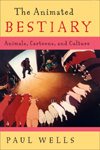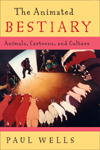The Animated Bestiary critically evaluates the depiction of animals in cartoons and animation more generally. Paul Wells argues that artists use animals to engage with issues that would be more difficult to address directly because of political, religious, or social taboos. Consequently, and principally through anthropomorphism, animation uses animals to play out a performance of gender, sex and sexuality, racial and national traits, and shifting identity, often challenging how we think about ourselves.
Wells draws on a wide range of examples, from the original King Kongto Nick Park's Chicken Run to Disney cartoonsùsuch as Tarzan, The Jungle Book, and Brother Bearùto reflect on people by looking at the ways in which they respond to animals in cartoons and films.
Wells has proven himself to be a leading scholar of animation and has here produced a solid piece of scholarship that shows an incredible breadth of knowledge.
Wells has proven himself to be a leading scholar of animation and has here produced a solid piece of scholarship that shows an incredible breadth of knowledge.
Of mice and men : what do animals mean?
"I don't care what you say, I'm cold" : anthropomorphism, practice, narrative
Which came first, the chicken or the egg? : performance, philosophy, tradition
Creature comforted : animal politics, animated memory





